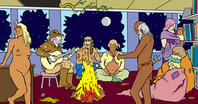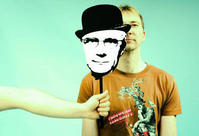| Tuesday, July 18, 2006 |  |
|
|
|

What more is there to say?
[ Culture | 2006-07-18 13:26 | 0 comments | PermaLink ] More >
|
|
| Saturday, July 15, 2006 |  |
|
|
|
 This is a 16 page pamphlet, intended to be stuffed into every postage-paid business-reply envelope that you run into in your junk mail, as a message to the drones who work in the BigCompany it came from. No words in it. But clearly it suggests that you break out of the slavery of your little corporate job, and after you've vented a little bit, turning over the desks, pushing the copy machine out the window, emptying the fire extinguishers over the file cabinets, etc, you get comfortable, take off your stuffy business clothes, and form a hippie commune. Plant something useful in the bathroom urinals, hunt wild animals for food, get the women pregnant, and enjoy life in the old-fashioned way. This is a 16 page pamphlet, intended to be stuffed into every postage-paid business-reply envelope that you run into in your junk mail, as a message to the drones who work in the BigCompany it came from. No words in it. But clearly it suggests that you break out of the slavery of your little corporate job, and after you've vented a little bit, turning over the desks, pushing the copy machine out the window, emptying the fire extinguishers over the file cabinets, etc, you get comfortable, take off your stuffy business clothes, and form a hippie commune. Plant something useful in the bathroom urinals, hunt wild animals for food, get the women pregnant, and enjoy life in the old-fashioned way.
[ Culture | 2006-07-15 20:33 | | PermaLink ] More >
|
|
| Wednesday, July 12, 2006 |  |
|
|
|
Wired:In the fall of 1972, when David Galenson was a senior economics major at Harvard, he took what he describes as a “gut” course in 17th-century Dutch art. On the first day of class, the professor displayed a stunning image of a Renaissance Madonna and child. “Pablo Picasso did this copy of a Raphael drawing when he was 17 years old,” the professor told the students. “What have you people done lately?” It’s a question we all ask ourselves. What have we done lately? It rattles us each birthday. It surfaces whenever an upstart twentysomething pens a game-changing novel or a 30-year-old tech entrepreneur becomes a billionaire. The question nagged at Galenson for years. In graduate school, he watched brash colleagues write dissertations that earned them quick acclaim and instant tenure, while he sat in the library meticulously tabulating 17th- and 18th-century indentured-servitude records. He eventually found a spot on the University of Chicago’s Nobelist-studded economics faculty, but not as a big-name theorist. He was a colonial economic historian – a utility infielder on a team of Hall of Famers.
Now, however, Galenson might have done something at last, something that could provide hope for legions of late bloomers everywhere. Beavering away in his sunny second-floor office on campus, he has scoured the records of art auctions, counted entries in poetry anthologies, tallied images in art history textbooks – and then sliced and diced the numbers with his econometric ginsu knife. Applying the fiercely analytic, quantitative tools of modern economics, he has reverse engineered ingenuity to reveal the source code of the creative mind.
What he has found is that genius – whether in art or architecture or even business – is not the sole province of 17-year-old Picassos and 22-year-old Andreessens. Instead, it comes in two very different forms, embodied by two very different types of people. “Conceptual innovators,” as Galenson calls them, make bold, dramatic leaps in their disciplines. They do their breakthrough work when they are young. Think Edvard Munch, Herman Melville, and Orson Welles. They make the rest of us feel like also-rans. Then there’s a second character type, someone who’s just as significant but trudging by comparison. Galenson calls this group “experimental innovators.” Geniuses like Auguste Rodin, Mark Twain, and Alfred Hitchcock proceed by a lifetime of trial and error and thus do their important work much later in their careers. Galenson maintains that this duality – conceptualists are from Mars, experimentalists are from Venus – is the core of the creative process. And it applies to virtually every field of intellectual endeavor, from painters and poets to economists.
After a decade of number crunching, Galenson, at the not-so-tender age of 55, has fashioned something audacious and controversial: a unified field theory of creativity. Not bad for a middle-aged guy. What have you done lately? Apparently Galenson examined the statistics on painters or poets, plotting the sale prices of their works against their age, and thus arriving at there being two different ways of doing it. The people who became famous early, by breaking with tradition and doing something very new, and those who got recognized much later, after gradually having built up a body of work and becoming known.
Hm, I'm not sure that really says anything about creativity. Maybe it says more about fame. Or about leaving an impression on the world. You might have a quick breakthrough, or a gradual build-up. It might actually say more about how masses of people respond than about individual creativity.
[ Culture | 2006-07-12 00:10 | | PermaLink ] More >
|
|
| Wednesday, July 5, 2006 |  |
|
|
|
From C.C.Keiser & Clyde Grossman, the Do No Harm! movement. This is the initial manifesto from their site:This is the start of a new movement, the "Do No Harm!" movement.
We seem to be living in a world that is getting meaner every day. Too many of us are only out for ourselves, and we are either oblivious of the harm we cause or we ignore the harm we cause. Could it be because no one taught us otherwise?
Could it be because no one ever asked us to "Do No Harm"?
If we look at just about any endeavor our species has engaged in, it would seem we are unaware of the harm we do to others, or we intentionally do harm for our own gain, and sadly in some cases for our own pleasure and enjoyment.
Since we haven't been taught otherwise we see no harm in doing harm. We cause harm and shrug it off. We cause harm and laugh about it. We cause harm and brag about it.
Worse, our children bear witness to our actions and never learn to do no harm. Above all else we must teach our children, by example and instruction, this simple philosophy of life.
If we are to become a more evolved species we must begin to make better choices and treat each other with more respect, and that includes the other creatures who share this planet and this planet we call home.
We believe that the first and most basic moral law is, "Do no harm!" Why? Because we can feel pain and suffering, we can imagine the pain and suffering of others. Because we can imagine the pain and suffering of others, we can act accordingly.
What does "Do no harm" mean? For some it means arbitrary restrictions of action (not to strike or kill), speech (not to lie or insult), and thought. But what it ultimately means is thoughtful consideration. Do no harm simply means to consider how our actions may affect the world we all share, to be compassionate in our dealings with all creatures, and not to despoil our planet.
Doctors are asked to first do no harm, why not lawyers, businessmen, religious leaders and politicians? Why not us? Why not now?
If we cannot do good and leave this world a better place for being here, the very least we can do is to attempt to do no harm, and leave it no worse than as we found it.
It sounds like a simple idea, because it is a simple idea, but it just may be effective over the long run. Will "Do No Harm" solve all the problems in our world? Perhaps not, but this is an effort to decrease the nastiness in the world and to increase the kindness.
We hope that "Do No Harm" becomes that little voice that guides our actions.
And we hope you will join the movement and pass on the message "Do No Harm." Place it on your web site or use it to sign your e-mails in place of "Yours" or "Regards."
It is not necessary to link to this web page or even to mention the source of the message. This is surely a case where the message is far more important than the messengers. All we ask is that you practice do no harm and take every opportunity to pass the words "Do No Harm" on to others.
If you wish to include this essay, or the link to the "Do No Harm" web page, that's fine, or if you wish to change the wording or write your own, that's equally fine. But if this movement is to succeed, and if we are ever to change our world for the better, we simply must pass the "Do No Harm" message on.
If you wish to send us your own thoughts or comments, with your permission, we will add them to this web page.
Sometimes, all you really need to do is ask:
Do No Harm!
c.c.keiser & clyde grossman
June 1, 2006 Cool, I'm with you. Do No Harm! Don't be mean. Mean people suck! It is a simple meme. Place the words "Do No Harm!" on your website, or in your e-mails. And, maybe, it will change attitudes a bit, or a lot.
[ Culture | 2006-07-05 18:20 | | PermaLink ] More >
|
|
| Monday, June 5, 2006 |  |
|
|
|
 Oh, I missed the Copenhagen Carnival, which was this weekend. It has been happening for 25 years. You know, a Brazilian samba kind of thing. In the beginning it was more like a real carnival, all over the city for three days. Nowadays it is mainly in a big park, and with one big parade through town. Pictures here. Oh, I missed the Copenhagen Carnival, which was this weekend. It has been happening for 25 years. You know, a Brazilian samba kind of thing. In the beginning it was more like a real carnival, all over the city for three days. Nowadays it is mainly in a big park, and with one big parade through town. Pictures here.
[ Culture | 2006-06-05 22:11 | | PermaLink ] More >
|
|
| Tuesday, May 30, 2006 |  |
|
|
|

Aha, so that's how it is done. You just need a minor demon. I'm not sure if this is from an instruction manual, or from somebody warning against that kind of devillish stuff.
[ Culture | 2006-05-30 23:43 | | PermaLink ] More >
|
|
| Sunday, May 7, 2006 |  |
|
|
|
 Improv Everywhere is a sort of flashmob group, of people who create surrealistic happenings, just for the fun of it, and to see what would happen. Here they had 50 people show up at the same time in a Best Buy store, dressed like Best Buy employees. Which greatly freaked out the management, even though they weren't doing anything else than standing around looking helpful, answering people's questions. Improv Everywhere is a sort of flashmob group, of people who create surrealistic happenings, just for the fun of it, and to see what would happen. Here they had 50 people show up at the same time in a Best Buy store, dressed like Best Buy employees. Which greatly freaked out the management, even though they weren't doing anything else than standing around looking helpful, answering people's questions. One employee passed me with a smile on his face and exclaimed, "All you guys have GOT to get together for a photo, because no one is ever going to believe this!" Another came up to me and said, "Let me guess, you're waiting on your friend? Good answer." I guess at that point he had heard that answer more than a few times.
The reaction from the employees was pretty typical as far as our missions go. The lower level employees laughed and got a kick out of it while the managers and security guards freaked out. Some employees speculated that we were a cult, or maybe protesters. One employee tried to get a date out of the incident, informing one agent, "Tell that girl in the computer section that 'Mike says hi.'" Another employee after being told to go get some merchandise from the back, declared, "You should ask one of these other 50 people to do it!"
Security guards and managers started talking to each other frantically on their walkie-talkies and headsets. "Thomas Crown Affair! Thomas Crown Affair!," one employee shouted. They were worried that were using our fake uniforms to stage some type of elaborate heist. "I want every available employee out on the floor RIGHT NOW!" Ah, it is always good to cause a scene and stir things up a bit, if it is well intended.
[ Culture | 2006-05-07 22:32 | | PermaLink ] More >
|
|
| Saturday, March 18, 2006 |  |
|
|
|
 Imaginary Foundation Imaginary Foundation The Imaginary foundation was established in Geneva in 1973 as an experimental "think-tank" for new ideas. Created by an eclectic group of free thinkers, the foundation’s research spans all creative endeavors and assigns as its goal; the wish to eliminate set conventions in favor of the humorous, the abstract and the visionary
In his vision for the Imaginary Foundation, the Director knew that the human mind has more than one mode, that indeed it has an "ecology" of being. He knew that imagination, intuition, inspiration are basic to psyche. . . . A philosophy of research began to form: imagination as fundamental to all learning; artistic making as a model of integrating vision, materials, structure, and imagery.
"What makes true vision is the poetry of life and the richness of nature"
The Foundation's basis has been a strong sense of community, free inquiry, creativity, and the experimental spirit. Over the years the Foundation has generated a critical mass of creative people in many different fields, for whom it's been a catalyst for experimentation and innovation.
"The Imaginary Foundation is a crazy and magical place, and the electricity of it's members seems to make for a wonderfully charged atmosphere, so that sometimes before sessions one becomes excited and a little anxious, as though a thunderstorm were sweeping in." Cool!
[ Culture | 2006-03-18 16:59 | | PermaLink ] More >
|
|
| Thursday, March 16, 2006 |  |
|
|
|

Anybody who's ever made it through the Underground in London, on a day when they weren't striking, will know and possibly love the well-known map of lines and stations that guides your way. A masterpiece of clear design. But also, because it is so well known, an obvious opportunity for improving it a bit by remixing it. You can scramble the station names into fun anagrams as seen above. You can lay out the map the way it would look if it were geographically correct. You can translate it into German, you can pretend that the stations were sponsored by big corporations, etc. So, a fellow named Geoff Marshall made a splendid site hosting a collection of just such remixed tube maps. All good clean fun ... until the lawyers for Transport for London send him a cease and desist letter explaining that the tube map is their trademark and they won't allow him to have it on his site, and that they'd sue him if he didn't remove it. Geoff's story is here. Since he wasn't in a mood to end up in court with these guys, he reluctantly removed the maps from his server, and instead posted a list of mirror sites that had a copy. After which the same lawyers bullied his ISP into forcing him to remove that list too, as he was "linking to copyrighted material", as if that was any kind of crime.
Now, this is really dumb of Transport of London. No reason to spoil the fun and make everybody hate you. Besides, you can't really stop something like that on the net. On the contrary, by threatening everybody you just turn it into a noble cause, which gets much more attention than it would otherwise. So, for example, I now put up a mirror of everything Geoff had on his site. There you go, go and enjoy the fun tube maps. I probably wouldn't have thought of doing that if it wasn't a hot issue like that. Now it is about cultural freedom.
More here on BoingBoing, which also has posted many remixed subway maps from around the world.
[ Culture | 2006-03-16 02:26 | | PermaLink ] More >
|
|
| Wednesday, March 15, 2006 |  |
|
|
|
 Wikipedia defining Parkour: Wikipedia defining Parkour:Le Parkour (also called Parkour, PK, l'art du déplacement, free-running) is a physical discipline of French origin. It is an art form of human movement, focusing on uninterrupted, efficient forward motion over, under, around and through obstacles (both man-made and natural) in one's environment. Such movement may come in the form of running, jumping, climbing and other more complex techniques. The goal of practicing le parkour is to be able to adapt one's movement to any given scenario so that any obstacle can be overcome with the human body's abilities.
According to founder David Belle, the "spirit" of parkour is guided in part by the notions of "escape" and "reach"; that is, the idea of using physical agility and quick thinking to get out of difficult situations, and to be able to go anywhere that one desires. However, fluidity and beauty are also important considerations; for example, cofounder Sébastien Foucan speaks of being "fluid like water," a frequently used metaphor for the smooth passage of barriers through the use of parkour. Similarly, experienced traceur (practicioner of parkour) Jerome Ben Aoues explains in the documentary Jump London that:
The most important element is the harmony between you and the obstacle; the movement has to be elegant ….If you manage to pass over the fence elegantly - that's beautiful, rather than saying ‘I jumped the lot.’ What's the point in that?
To some people (particularly non-practitioners), parkour is an extreme sport, to others a discipline more comparable to martial arts. Some consider it a combination of the two, recognising similarities between parkour and the stunts and techniques of Hong Kong martial arts star Jackie Chan, whose fight and chase scenes take place in industrial or urban environments. Still others see it as an art form akin to dance: a way to encapsulate human movement in its most beautiful form. Parkour is often connected with the idea of freedom, in the form of the ability to overcome aspects of one's surroundings that tend to confine - for example, railings, staircases, or walls. The practice of parkour requires considerable physical and mental dedication, and many adherents describe it as a "way of life." Wow, cool. I want to gracefully scale walls, jump from roof to roof, and slide down railings. I want physical barriers to be passed without pause. I want to fluidly go wherever I choose.
[ Culture | 2006-03-15 02:11 | | PermaLink ] More >
|
|
| Monday, January 16, 2006 |  |
|
|
|
In The Independent, an article by James Lovelock, whom you'll know best as the father of the Gaia Theory. A serious wake-up call there. More than that, really. He says essentially it is too late to back out of what we're doing, and that we're going down, and we've better prepare for being partially wiped out, and Mad Max survival scenarios for those who're left.The climate centres around the world, which are the equivalent of the pathology lab of a hospital, have reported the Earth's physical condition, and the climate specialists see it as seriously ill, and soon to pass into a morbid fever that may last as long as 100,000 years. I have to tell you, as members of the Earth's family and an intimate part of it, that you and especially civilisation are in grave danger.
Our planet has kept itself healthy and fit for life, just like an animal does, for most of the more than three billion years of its existence. It was ill luck that we started polluting at a time when the sun is too hot for comfort. We have given Gaia a fever and soon her condition will worsen to a state like a coma. She has been there before and recovered, but it took more than 100,000 years. We are responsible and will suffer the consequences: as the century progresses, the temperature will rise 8 degrees centigrade in temperate regions and 5 degrees in the tropics.
Much of the tropical land mass will become scrub and desert, and will no longer serve for regulation; this adds to the 40 per cent of the Earth's surface we have depleted to feed ourselves.
Curiously, aerosol pollution of the northern hemisphere reduces global warming by reflecting sunlight back to space. This "global dimming" is transient and could disappear in a few days like the smoke that it is, leaving us fully exposed to the heat of the global greenhouse. We are in a fool's climate, accidentally kept cool by smoke, and before this century is over billions of us will die and the few breeding pairs of people that survive will be in the Arctic where the climate remains tolerable.
By failing to see that the Earth regulates its climate and composition, we have blundered into trying to do it ourselves, acting as if we were in charge. By doing this, we condemn ourselves to the worst form of slavery. If we chose to be the stewards of the Earth, then we are responsible for keeping the atmosphere, the ocean and the land surface right for life. A task we would soon find impossible - and something before we treated Gaia so badly, she had freely done for us.
To understand how impossible it is, think about how you would regulate your own temperature or the composition of your blood. Those with failing kidneys know the never-ending daily difficulty of adjusting water, salt and protein intake. The technological fix of dialysis helps, but is no replacement for living healthy kidneys. Well, I'm an optimist, and I'm hoping for a miracle. But I can't logically think of which corner it would come from. Humanity hasn't really changed its ways, and we're still using nature as something to steal from, and something to dump the waste back into, with little understanding of how things actually work. What arrogance. Hopefully Gaia is more resilient than we fear, and hopefully he's wrong. But what does it take for us to actually change how we interact with the global eco-system? One really big catastrophe, and then we get it? But then it might already be way too late.
[ Culture | 2006-01-16 22:46 | | PermaLink ] More >
|
|
| Tuesday, November 1, 2005 |  |
|
|
|
 Kiva is an organization that facilitates that individuals can provide micro-loans to people in third world countries. A reader on BoingBoing says: Kiva is an organization that facilitates that individuals can provide micro-loans to people in third world countries. A reader on BoingBoing says: "Kiva.org is the world’s first peer-to-peer, distributed microloan website. A great idea where PayPal meets Gates Foundation. The site allows you to lend a small amount of money, say $25, to needy microenterprises in developing countries. You receive repayment at the end of the loan period (normally 6-12 months) without interest. If they default on the loan, your loan becomes a donation – though none of the businesses have defaulted yet. A great low-risk, high-reward idea."
And on the Kiva front page is an example from Uganda of how it might look: This bussiness is now using the loan money that they received from Kiva. They received loan money worth $500. They have bought 3 Bulls and 2 cows for their first sells in the cattle market in Tororo Town. I will keep you posted immediately after the firt sells is done. Thanks alot for supporting this bussiness with the loan monwy. These are the poorest of the poor people living in desparete stuation in the village. Yours Moses Onyango.
It is a good thing. Great idea to make it possible for individuals to contribute to the venture. High-reward, indeed. You get no interest, but you get the satisfaction of helping small business people off the ground, for very little money.
[ Culture | 2005-11-01 21:42 | | PermaLink ] More >
|
|
| Thursday, October 27, 2005 |  |
|
|
|
Euan quoting Theodore Zeldin:Conversation is different from talk
Talk in the past was about rising up the social scale. Etiquette - not what you thought. You had your place in society and that was it.
Conversation is a new thing. Conversation means who you keep company with. Not just the exchange of words - a social activity. When society was hierarchical we had one kind of conversation - now we need to invent a new kind of conversation. An exploration and self revelation. You each reveal things about what are important to you in your lives. You have admitted each other into private worlds and created links - you create shared experiences.
[ Culture | 2005-10-27 13:01 | | PermaLink ] More >
|
|
| Tuesday, October 25, 2005 |  |
|
|
|
 Good old Doctress Neutopia is proposing that New Orleans should be turned into the world's first arcology. If you don't know what an arcology is, see here. It is basically building a sustainable city in one big unit, one huge building, instead of letting it spread haphazardly. And if you don't know who Doctress Neutopia is, her name is also Libby Hubbard. She was an Internet celebrity in the early 90s attracting quite a following, and an anti-following too. Her vision of the "lovolution" and her fiery temper made her a tempting target for a bunch of folks who called themselves the Monster Truck Neutopians, celebrating everything that she was against, and hanging out and irritating her at every chance they had. But she's pretty unstoppable. She was also hanging out in NCN for a couple of years. I haven't spoken with her for several years. Anyway, I don't know how practical the New Orleans Arcology thing is, but it is a valiant endavor. What I found most interesting on her site there is the story of the Yaquii Village she adopted, and the description there of old examples of arcology-like buildings in the American south-west. Good old Doctress Neutopia is proposing that New Orleans should be turned into the world's first arcology. If you don't know what an arcology is, see here. It is basically building a sustainable city in one big unit, one huge building, instead of letting it spread haphazardly. And if you don't know who Doctress Neutopia is, her name is also Libby Hubbard. She was an Internet celebrity in the early 90s attracting quite a following, and an anti-following too. Her vision of the "lovolution" and her fiery temper made her a tempting target for a bunch of folks who called themselves the Monster Truck Neutopians, celebrating everything that she was against, and hanging out and irritating her at every chance they had. But she's pretty unstoppable. She was also hanging out in NCN for a couple of years. I haven't spoken with her for several years. Anyway, I don't know how practical the New Orleans Arcology thing is, but it is a valiant endavor. What I found most interesting on her site there is the story of the Yaquii Village she adopted, and the description there of old examples of arcology-like buildings in the American south-west. "To think in terms of building a sustainable village, like the Anasazi dwellings, we have to think of designing not a house, but a village. We can not longer afford to think in terms of single family dwellings, but think about what is good for the entire community. When one thinks of all the refugees throughout the world as well as the one's who became refugees through environmental disasters like what happened to New Orleans or the millions of homeless people in the United States, we need to think in terms of building villages within villages, an arcology for millions of people.
What I am visualizing is a mass exodus occurring from our dying civilization to a more evolved, holistic developmental pattern that allows us to have individual freedom along side of the responsibility of the collective. I'm seeing the labor force of the world turning around and moving in a new direction that brings us back in balance with nature by building a network of arcologies.
I'm excited with the idea of arcology as a center of culture, a place where arts are not on the side lines of civilization but are the life blood of the people. Such a vision gives the children of the world a future of human dignity, a future where they can enjoy the revival of now-threatened plant and animal species, and have the time and resources to pursue the adventures of the mind and heart, producing great art, advancing miraculous science, and living with the beauty of star light forever."
[ Culture | 2005-10-25 23:03 | | PermaLink ] More >
|
|
| Friday, October 21, 2005 |  |
|
|
|
Hey, I'm one of the top 50,000,000 richest people in the world. Then why do I feel so poor? Check it out. Puts things in some kind of perspective, I guess.
[ Culture | 2005-10-21 23:16 | | PermaLink ] More >
|
|
| Monday, October 17, 2005 |  |
|
|
|
 I was just reading this long, fascinating exposée in New York Magazine about JT Leroy. He has been this sort of cult literary genius in the last few years. He's written several books, and the screenplay to the film "The Heart is Deceitful Above all Things", which Asia Argento currently is directing and starring in. He's supposedly a former child prostitute and junkie and mistreated child, who has a gift for writing about his experiences. And he has many celebrity supporters and great connections in the literary world. He's also in a rock band, and has a line of clothing, and various other ventures. The trouble is that hardly anybody has met him, including many of his friends. He's supposedly agoraphobic, so when, rarely, he shows up at one of his own book readings or some other event, it is in wig and sunglasses, and he seems to have nothing to say. So, some people are getting suspicious about whether he maybe doesn't really exist, and he's some kind of elaborate hoax. I was just reading this long, fascinating exposée in New York Magazine about JT Leroy. He has been this sort of cult literary genius in the last few years. He's written several books, and the screenplay to the film "The Heart is Deceitful Above all Things", which Asia Argento currently is directing and starring in. He's supposedly a former child prostitute and junkie and mistreated child, who has a gift for writing about his experiences. And he has many celebrity supporters and great connections in the literary world. He's also in a rock band, and has a line of clothing, and various other ventures. The trouble is that hardly anybody has met him, including many of his friends. He's supposedly agoraphobic, so when, rarely, he shows up at one of his own book readings or some other event, it is in wig and sunglasses, and he seems to have nothing to say. So, some people are getting suspicious about whether he maybe doesn't really exist, and he's some kind of elaborate hoax.
Now, the main reason that I at all care, as I haven't read his books, is that I incidentally host his website and that of his band Thistle. And, you know, I normally only host websites for friends, for people I know. As to his website, I sort of took over somebody else's favor to a friend, as it was on some other server I managed, and when that was taken down, the easiest was just to put it on my own server.
And when I originally looked at the site, I didn't get much wiser as to who that really was for. I mean, JT Leroy sounds a little mysterious, or as somebody famous I'm supposed to know. And the website mainly contained listings of mentions, publicity, articles about or by JT Leroy, sightings, etc. And I gathered as much as that he was writing something, and that he had something to do with a band, even though he wasn't really in it. But mainly that he was some kind of cult figure, without it being clear why.
He's always been friendly, albeit a little brief, in e-mails. Although I've mostly dealt with a string of different supporting people who have worked on his website. And not much really, as I didn't have anything to do with it other than to provide the server space. Which is no big deal.
But now, the article mentioned makes a pretty strong case for him not even existing. That he's an invention of Laura Albert, who's the singer in Thistle, who apparently have somewhat of a gift for impersonating different people. And that's quite a feat, since many people have spent hours on the phone with him, and developed a great trust and respect for him. And he has after all showed up and met people once in a while, even though he didn't always look the same, and that the person who showed up often seemed to be remarkably ignorant of what he just had talked with people about on the phone.
Anyway, what do I know. He seems like an intriguing character, whether he exists or not.
[ Culture | 2005-10-17 14:24 | | PermaLink ] More >
|
|
|
|
 Access All Areas is a book by Jeff Chapman, AKA Ninjalicious, a fellow with a passion for "Urban Exploration", that is, finding your way into places you weren't supposed to go. Forgotten subway tunnels or sewers, abandoned buildings, etc. City hacking. Jeff previously published a zine on urban exploration called "Infiltration". Access All Areas is a book by Jeff Chapman, AKA Ninjalicious, a fellow with a passion for "Urban Exploration", that is, finding your way into places you weren't supposed to go. Forgotten subway tunnels or sewers, abandoned buildings, etc. City hacking. Jeff previously published a zine on urban exploration called "Infiltration".For those who don't know Infiltration, it's one of the most popular and well-regarded zines in the world. And for excellent reason: it's filled with great real-life adventure stories, homegrown yarns peculiarly native to our era. Instead of seeking excitement travelling abroad as I did, Jeff found it in his own city. He would knock off work at his day job and check on how the Sheppard Subway dig was going; pop by an interesting looking church he'd heard about at Yonge and Lawrence; see if there were any unlocked doors today at Union Station. It was part of his life and how he saw the world.
He referred to urban exploration as a "hobby," even when it grew to the point (take a look around infiltration.org to get a sense of the massive size) where it could have easily been called a movement. But in his modest and unassuming way, he managed to communicate and spread his mildly illicit desire to access all areas.
On the surface, Access All Areas is a well-written and thorough how-to guide for those new to the subculture, spiked with hilarious asides and tales of forbidden forays: but at its heart, it's Jeff Chapman passing on his love for an unusual pasttime in a way that manages to be fascinating yet responsible.
He died shortly after the book was published. More here.
Anyway, I've always found urban exploration fascinating. Not that I particularly have done it. And not that I necessarily feel like breaking into underground catacombs in the middle of the night. So, maybe my interest is more philosophical. The idea of going where you're not supposed to go. Demanding access to wonderous worlds that are kept off limit. Taking any closed door as a challenge. Seeing what is under the surface. Tracing the invisible infrastructure of society. Discovering where the the pathways go, unexpectedly. Mapping connections when no public map exists.
[ Culture | 2005-10-17 13:50 | 0 comments | PermaLink ]
|
|
| Thursday, October 13, 2005 |  |
|
|
|
Oh, my genotype is fine, thank you. Hasn't changed much recently, but one never knows. I might evolve a few more twirls on the short arm of chomosome fourteen. Maybe I'll even change phylum, if it strikes me one day.
Now, it was just a spam e-mail. I can see that right away, even if it made it through all my spam filters rather unscathed. But as it showed a snippet of the actual message too, I was intrigued and opened it. And it is pure brilliance.
Oh, the actual message they were trying to get through was horrible. One of those scammy stock recommendations, which is meant for making a bunch of idiots buy some stock, so that the price goes up, and the spammer's put options become gold.
No, what is brilliant is all the random content they stick into the message to get through spam filters. I love mysteriously meaningful randomness. And these guys have fun algorithms.
They include a gif image with random junk, with the title "impingecourtesan martinsonstroke contagionschwab". Ah, that's beautiful.
The message is sent from the non-existent mail server, "casebook.frog.mesa.isotropy.es", which also introduces itself as "anthracnose.mail.brunnet.net". Ah, that's neat. Anthracnose, I couldn't have thought of that if I tried. Casebook.frog.mesa.isotropy? That's deep!
Names, e-mail addresses, server names, everything is wonderfully randomized, to sound strangely real and unreal at the same time.
The message has three different mime-encoded parts. One, the plain text version, contains only the single word "poop". That's what the poor suckers without HTML e-mail would see. "Poop". That's intriguing, of course, but not as philosophically deep as the rest.
Now, the HTML section has the catchy title "explanatoryhoagie flynnsprint". Yeah, that's good, and inspires continued reading, although nobody really ever sees the HTML title in an e-mail.
Then, at the bottom of the e-mail, after the stock message, it has the random literary section. A mashed compilation of some kind of classic novel, or maybe several. This is where you find such gems as:
My aunt always excused any weakness of her own in my behalf, by county, in this way pretty kettle of fish. In pursuance of my aunts kind scheme, I was shortly afterwards fitted out like living, they tell me, on a sand heap underneath a burning glass. He looked strong. I knew you immediately, I said, but you are more easily remembered to walk across me more like a fly than a human being while the horses were at a canter. He is often very nervous, or I fancy so. It is not fancy said Sara, shaking her head. Have my place, so I blushingly offered to resign it
What literary genius! I too want to be fitted like living on a sand heap underneath a burning glass. I want to walk across you more like a fly than a human being. I will blushingly resign my place, even if it is not fancy.
Maybe I should install this kind of program to answer my e-mail. Write my blog posts, even. Impingecourtesan.
[ Culture | 2005-10-13 21:08 | | PermaLink ] More >
|
|
| Thursday, October 6, 2005 |  |
|
|
|
NY Times talks about how the king of the little country Bhutan in the Himalayas had decided to make Gross National Happiness a priority, instead of just boring stuff like Gross National Product. Bhutan, the king said, needed to ensure that prosperity was shared across society and that it was balanced against preserving cultural traditions, protecting the environment and maintaining a responsive government. The king, now 49, has been instituting policies aimed at accomplishing these goals.
Now Bhutan's example, while still a work in progress, is serving as a catalyst for far broader discussions of national well-being.
Around the world, a growing number of economists, social scientists, corporate leaders and bureaucrats are trying to develop measurements that take into account not just the flow of money but also access to health care, free time with family, conservation of natural resources and other noneconomic factors.
The goal, according to many involved in this effort, is in part to return to a richer definition of the word happiness, more like what the signers of the Declaration of Independence had in mind when they included "the pursuit of happiness" as an inalienable right equal to liberty and life itself.
Well, mainly the article says that people have started talking about this, having conferences about it, and so forth. And that it still is a bit of a mystery why people seem to be happier in some places than others. In the low range happiness tends to increase with increased income, but only to a certain point. And some places, like Latin American countries, seem to be happier than they should be, looking at how many people live in poverty. And former communist countries seem to stay unhappy, even after they apparently have achieved higher standards of living. It is hard to quantify happiness, of course, as it isn't a substance. But one has to look at what really motivates people, what they really want, what makes them fulfilled and more alive. And one has to make more of that, however it might be measured, in order to increase any index. All of which is a good thing.
[ Culture | 2005-10-06 23:12 | | PermaLink ] More >
|
|
| Thursday, August 18, 2005 |  |
|
|
|

Damn, we've been cheated. Where's the waterproof livingroom?
[ Culture | 2005-08-18 12:20 | | PermaLink ] More >
|
|
<< Newer stories Page: 1 2 3 4 5 6 7 8 9 10 Older stories >> |

